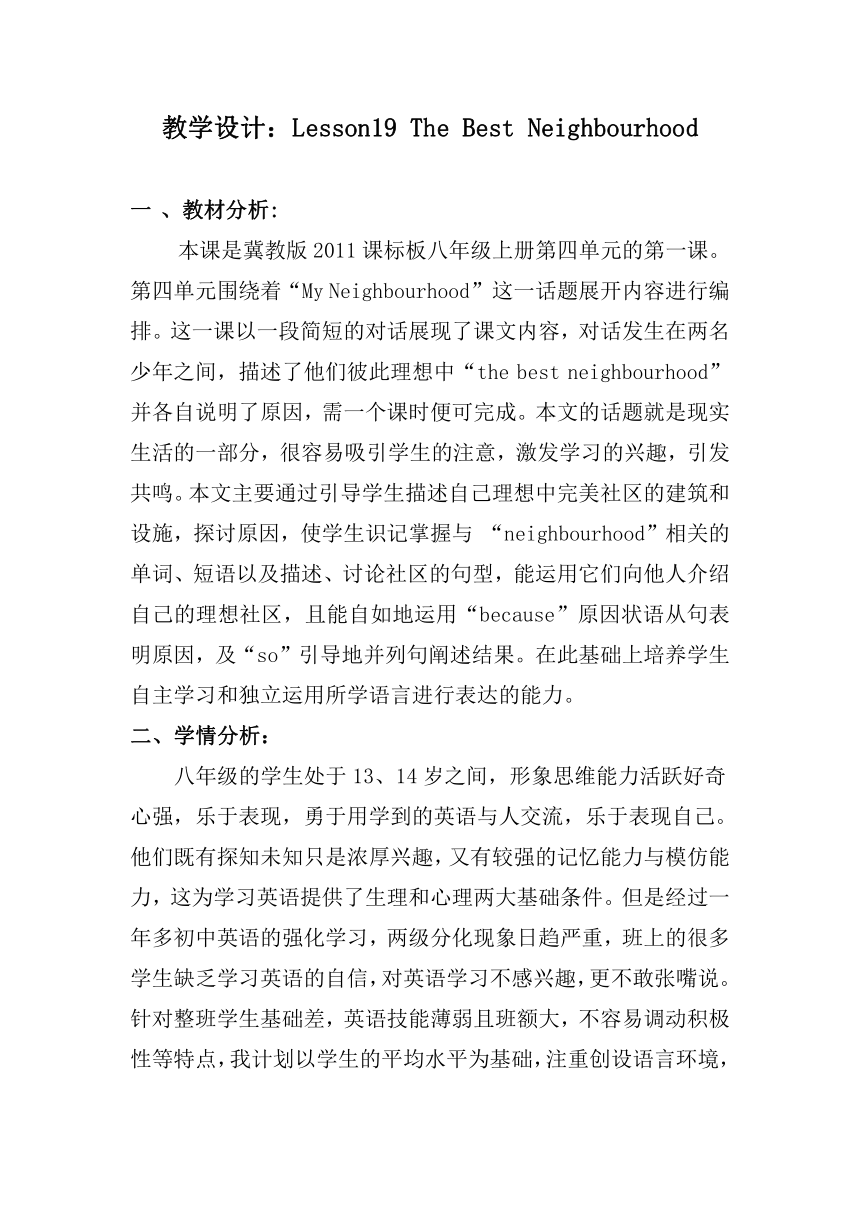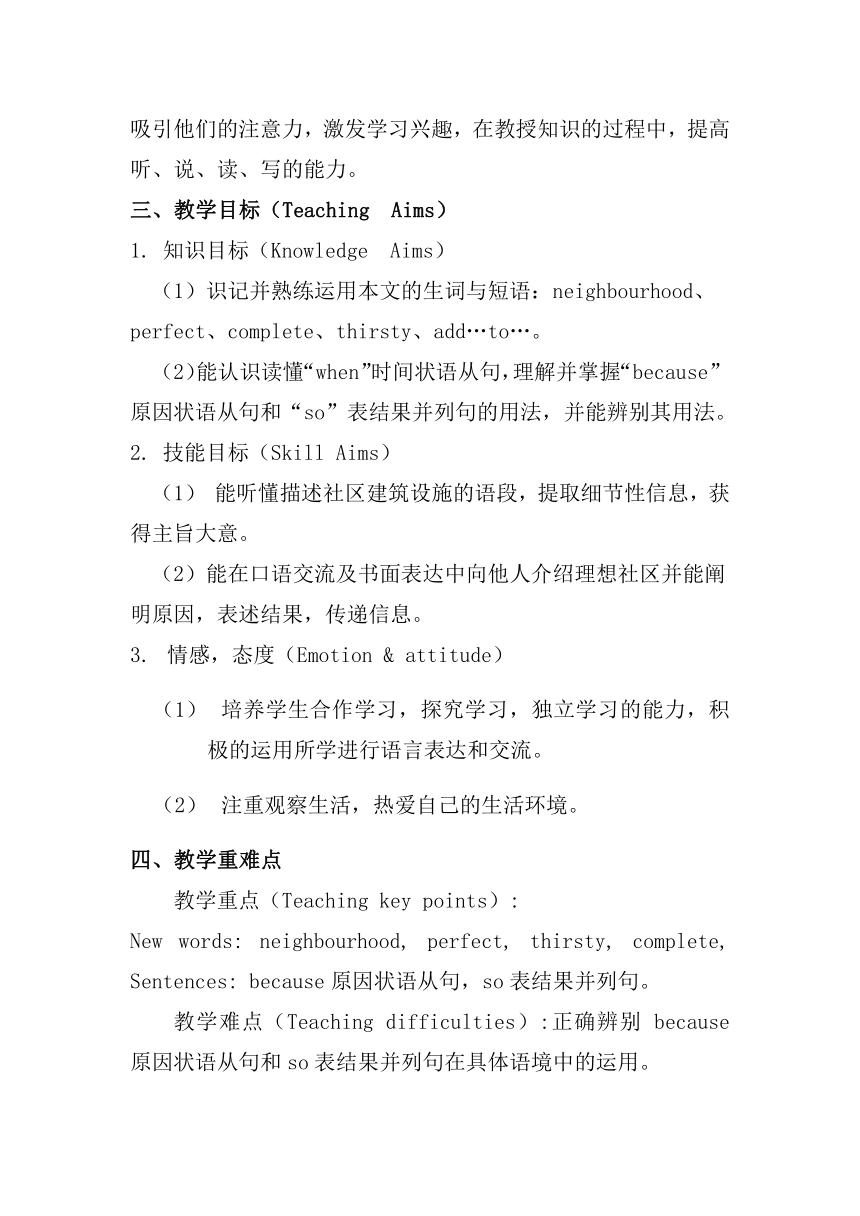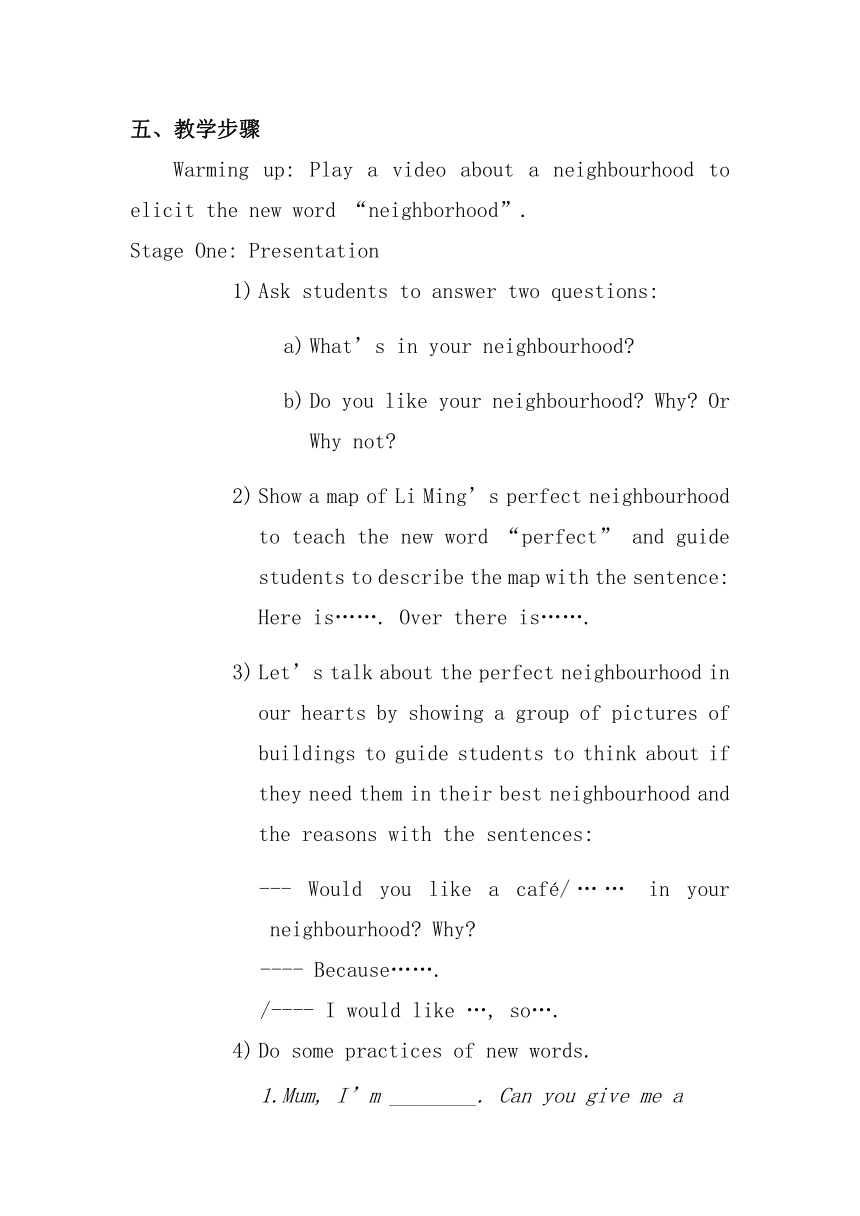冀教版八年级上册 Unit 4 Lesson 19 The Best Neighbourhood.教案
文档属性
| 名称 | 冀教版八年级上册 Unit 4 Lesson 19 The Best Neighbourhood.教案 |  | |
| 格式 | doc | ||
| 文件大小 | 42.5KB | ||
| 资源类型 | 教案 | ||
| 版本资源 | 冀教版 | ||
| 科目 | 英语 | ||
| 更新时间 | 2022-08-27 20:23:32 | ||
图片预览



文档简介
教学设计:Lesson19 The Best Neighbourhood
一 、教材分析:
本课是冀教版2011课标板八年级上册第四单元的第一课。第四单元围绕着“My Neighbourhood”这一话题展开内容进行编排。这一课以一段简短的对话展现了课文内容,对话发生在两名少年之间,描述了他们彼此理想中“the best neighbourhood”并各自说明了原因,需一个课时便可完成。本文的话题就是现实生活的一部分,很容易吸引学生的注意,激发学习的兴趣,引发共鸣。本文主要通过引导学生描述自己理想中完美社区的建筑和设施,探讨原因,使学生识记掌握与 “neighbourhood”相关的单词、短语以及描述、讨论社区的句型,能运用它们向他人介绍自己的理想社区,且能自如地运用“because”原因状语从句表明原因,及“so”引导地并列句阐述结果。在此基础上培养学生自主学习和独立运用所学语言进行表达的能力。
二、学情分析:
八年级的学生处于13、14岁之间,形象思维能力活跃好奇
心强,乐于表现,勇于用学到的英语与人交流,乐于表现自己。
他们既有探知未知只是浓厚兴趣,又有较强的记忆能力与模仿能
力,这为学习英语提供了生理和心理两大基础条件。但是经过一
年多初中英语的强化学习,两级分化现象日趋严重,班上的很多
学生缺乏学习英语的自信,对英语学习不感兴趣,更不敢张嘴说。
针对整班学生基础差,英语技能薄弱且班额大,不容易调动积极
性等特点,我计划以学生的平均水平为基础,注重创设语言环境,
吸引他们的注意力,激发学习兴趣,在教授知识的过程中,提高
听、说、读、写的能力。
三、教学目标(Teaching Aims)
1. 知识目标(Knowledge Aims)
(1)识记并熟练运用本文的生词与短语:neighbourhood、 perfect、complete、thirsty、add…to…。
(2)能认识读懂“when”时间状语从句,理解并掌握“because”原因状语从句和“so”表结果并列句的用法,并能辨别其用法。
2. 技能目标(Skill Aims)
(1) 能听懂描述社区建筑设施的语段,提取细节性信息,获得主旨大意。
(2)能在口语交流及书面表达中向他人介绍理想社区并能阐明原因,表述结果,传递信息。
3. 情感,态度(Emotion & attitude)
(1) 培养学生合作学习,探究学习,独立学习的能力,积极的运用所学进行语言表达和交流。
(2) 注重观察生活,热爱自己的生活环境。
四、教学重难点
教学重点(Teaching key points):
New words: neighbourhood, perfect, thirsty, complete, Sentences: because原因状语从句,so表结果并列句。
教学难点(Teaching difficulties):正确辨别 because原因状语从句和so表结果并列句在具体语境中的运用。
五、教学步骤
Warming up: Play a video about a neighbourhood to elicit the new word “neighborhood”.
Stage One: Presentation
1) Ask students to answer two questions:
a) What’s in your neighbourhood
b) Do you like your neighbourhood Why Or Why not
2) Show a map of Li Ming’s perfect neighbourhood to teach the new word “perfect” and guide students to describe the map with the sentence: Here is……. Over there is…….
3) Let’s talk about the perfect neighbourhood in our hearts by showing a group of pictures of buildings to guide students to think about if they need them in their best neighbourhood and the reasons with the sentences:
--- Would you like a café/…… in your neighbourhood Why
---- Because…….
/---- I would like …, so….
4) Do some practices of new words.
1.Mum, I’m ________. Can you give me a
glass of water, please
2.Let’ s ________ the work quickly. It’s time to go for lunch.
3. She felt cold ________ it was snowing heavily.
4. He spoke ________ English in his speech.
Stage Two: Practice
1) Activity 1: Listen and answer questions
a) Listen and watch the video of the text once to answer the question “What’s in each person’s neighbourhood ”
b) Listen to the text twice more and match the answer with the questions.
2) Activity 2 : Pair Work: Dictate each other and fill in blanks
Both Li Ming and Wang Mei drew a map of a _______ _______________. Li Ming drew a park and a corner store, ________he can play basketball there, and buy drinks ______ he is ______. Wang Mei drew 3 bookstores ________ she wants to buy lots of books . And _____ ____ is a market. Her mother won’t have to ____ ____ to buy vegetables and fruits. She also_____ a Canadian restaurant to __________ her map. She can take Jenny there when she _____ ____ a _______.
One read the text to your partner once. Meanwhile the partner fills blanks in the paper according to what he has heard. Then in turn, do it again until the pair both complete all blanks.
Each pair can read the text to each other several times among 5 mins.
Stage Three: Production
1) Activity 3: Pair Work: make a dialogue
Make a dialogue in group of two like this:
A: What would you like in your neighbourhood
B: A park/ grocery store/..............
A: Why
B: Because...............
What about you
A: A park/ grocery store/............, so I can go for a walk/...........
2) Activity 4 Group Work
Talk about and design your ideal neighbourhood in groups, then write a short passage with 5 or 6 sentences at least.
like this:
We want ....... in our neighbourhood,
so/because........
一 、教材分析:
本课是冀教版2011课标板八年级上册第四单元的第一课。第四单元围绕着“My Neighbourhood”这一话题展开内容进行编排。这一课以一段简短的对话展现了课文内容,对话发生在两名少年之间,描述了他们彼此理想中“the best neighbourhood”并各自说明了原因,需一个课时便可完成。本文的话题就是现实生活的一部分,很容易吸引学生的注意,激发学习的兴趣,引发共鸣。本文主要通过引导学生描述自己理想中完美社区的建筑和设施,探讨原因,使学生识记掌握与 “neighbourhood”相关的单词、短语以及描述、讨论社区的句型,能运用它们向他人介绍自己的理想社区,且能自如地运用“because”原因状语从句表明原因,及“so”引导地并列句阐述结果。在此基础上培养学生自主学习和独立运用所学语言进行表达的能力。
二、学情分析:
八年级的学生处于13、14岁之间,形象思维能力活跃好奇
心强,乐于表现,勇于用学到的英语与人交流,乐于表现自己。
他们既有探知未知只是浓厚兴趣,又有较强的记忆能力与模仿能
力,这为学习英语提供了生理和心理两大基础条件。但是经过一
年多初中英语的强化学习,两级分化现象日趋严重,班上的很多
学生缺乏学习英语的自信,对英语学习不感兴趣,更不敢张嘴说。
针对整班学生基础差,英语技能薄弱且班额大,不容易调动积极
性等特点,我计划以学生的平均水平为基础,注重创设语言环境,
吸引他们的注意力,激发学习兴趣,在教授知识的过程中,提高
听、说、读、写的能力。
三、教学目标(Teaching Aims)
1. 知识目标(Knowledge Aims)
(1)识记并熟练运用本文的生词与短语:neighbourhood、 perfect、complete、thirsty、add…to…。
(2)能认识读懂“when”时间状语从句,理解并掌握“because”原因状语从句和“so”表结果并列句的用法,并能辨别其用法。
2. 技能目标(Skill Aims)
(1) 能听懂描述社区建筑设施的语段,提取细节性信息,获得主旨大意。
(2)能在口语交流及书面表达中向他人介绍理想社区并能阐明原因,表述结果,传递信息。
3. 情感,态度(Emotion & attitude)
(1) 培养学生合作学习,探究学习,独立学习的能力,积极的运用所学进行语言表达和交流。
(2) 注重观察生活,热爱自己的生活环境。
四、教学重难点
教学重点(Teaching key points):
New words: neighbourhood, perfect, thirsty, complete, Sentences: because原因状语从句,so表结果并列句。
教学难点(Teaching difficulties):正确辨别 because原因状语从句和so表结果并列句在具体语境中的运用。
五、教学步骤
Warming up: Play a video about a neighbourhood to elicit the new word “neighborhood”.
Stage One: Presentation
1) Ask students to answer two questions:
a) What’s in your neighbourhood
b) Do you like your neighbourhood Why Or Why not
2) Show a map of Li Ming’s perfect neighbourhood to teach the new word “perfect” and guide students to describe the map with the sentence: Here is……. Over there is…….
3) Let’s talk about the perfect neighbourhood in our hearts by showing a group of pictures of buildings to guide students to think about if they need them in their best neighbourhood and the reasons with the sentences:
--- Would you like a café/…… in your neighbourhood Why
---- Because…….
/---- I would like …, so….
4) Do some practices of new words.
1.Mum, I’m ________. Can you give me a
glass of water, please
2.Let’ s ________ the work quickly. It’s time to go for lunch.
3. She felt cold ________ it was snowing heavily.
4. He spoke ________ English in his speech.
Stage Two: Practice
1) Activity 1: Listen and answer questions
a) Listen and watch the video of the text once to answer the question “What’s in each person’s neighbourhood ”
b) Listen to the text twice more and match the answer with the questions.
2) Activity 2 : Pair Work: Dictate each other and fill in blanks
Both Li Ming and Wang Mei drew a map of a _______ _______________. Li Ming drew a park and a corner store, ________he can play basketball there, and buy drinks ______ he is ______. Wang Mei drew 3 bookstores ________ she wants to buy lots of books . And _____ ____ is a market. Her mother won’t have to ____ ____ to buy vegetables and fruits. She also_____ a Canadian restaurant to __________ her map. She can take Jenny there when she _____ ____ a _______.
One read the text to your partner once. Meanwhile the partner fills blanks in the paper according to what he has heard. Then in turn, do it again until the pair both complete all blanks.
Each pair can read the text to each other several times among 5 mins.
Stage Three: Production
1) Activity 3: Pair Work: make a dialogue
Make a dialogue in group of two like this:
A: What would you like in your neighbourhood
B: A park/ grocery store/..............
A: Why
B: Because...............
What about you
A: A park/ grocery store/............, so I can go for a walk/...........
2) Activity 4 Group Work
Talk about and design your ideal neighbourhood in groups, then write a short passage with 5 or 6 sentences at least.
like this:
We want ....... in our neighbourhood,
so/because........
同课章节目录
- Unit 1 Me and My Class
- Lesson 1 Back to School!
- Lesson 2 Many Faces, One Picture
- Lesson 3 Getting to Know You!
- Lesson 4 Best Friends
- Lesson 5 Meet Ms. Liu
- Lesson 6 Jenny's Week
- Unit 2 My Favourite School Subject
- Lesson 7 Don't Be Late for Class!
- Lesson 8 E-mail Helpers!
- Lesson 9 I Don't Want to Miss Geography !
- Lesson 10 Looking for Lisa
- Lesson 11 Lily Learns about China !
- Lesson 12 Karen's Hair Stood Up!
- Unit Review
- Unit 3 Families Celebrate Togethe
- Lesson 13 I Love Autumn
- Lesson 14 Happy Memories
- Lesson 15 A Present for Li Ming!
- Lesson 16 Happy Thanksgiving!
- Lesson 17 Presents from Canada!
- Lesson 18 Li Ming's Birthday
- Unit Review
- Unit 4 My Neighbourhood
- Lesson 19 The Best Neighourhood
- Lesson 20 No Stopping!
- Lesson 21 Eat a Donut and Turn Right
- Lesson 22 I Like My Neighbourhood
- Lesson 23 People in My Neighbourhood
- Lesson 24 I Need a Map!
- Unit Review
- Unit 5 My Future
- Lesson 25 I Want to Be a Teacher!
- Lesson 26 What Will I Be ?
- Lesson 27 What's Your Advice?
- Lesson 28 Rich or Poor? It Doesn't Matter!
- Lesson 29 Our Ambitions and Dreams
- Lesson 30 A Famous Friend?
- Unit Review
- Unit 6 Go With Transportation !
- Lesson 31 How Do You Travel ?
- Lesson 32 Trains Go Faster !
- Lesson 33 Life on Wheels
- Lesson 34 Flying Donuts
- Lesson 35 Future Transportation
- Lesson 36 Clean Cars ?
- Unit Review
- Unit 7 Enjoy Your Hobby
- Lesson 37 What's Your Hobby ?
- Lesson 38 Hobbies Are Fun!
- Lesson 39 Danny's Hobby
- Lesson 40 What's Paul's Hobby?
- Lesson 41 Show and Tell!
- Lesson 42 The New Club
- Unit Review
- Unit 8 Celebrating Me
- Lesson 43 What Makes You Unique?
- Lesson 44 Georgia Plays Basketball
- Lesson 45 Be Yourself !
- Lesson 46 My Dream
- Lesson 47 I Made It !
- Lesson 48 Li Ming's Report
- Unit Review
